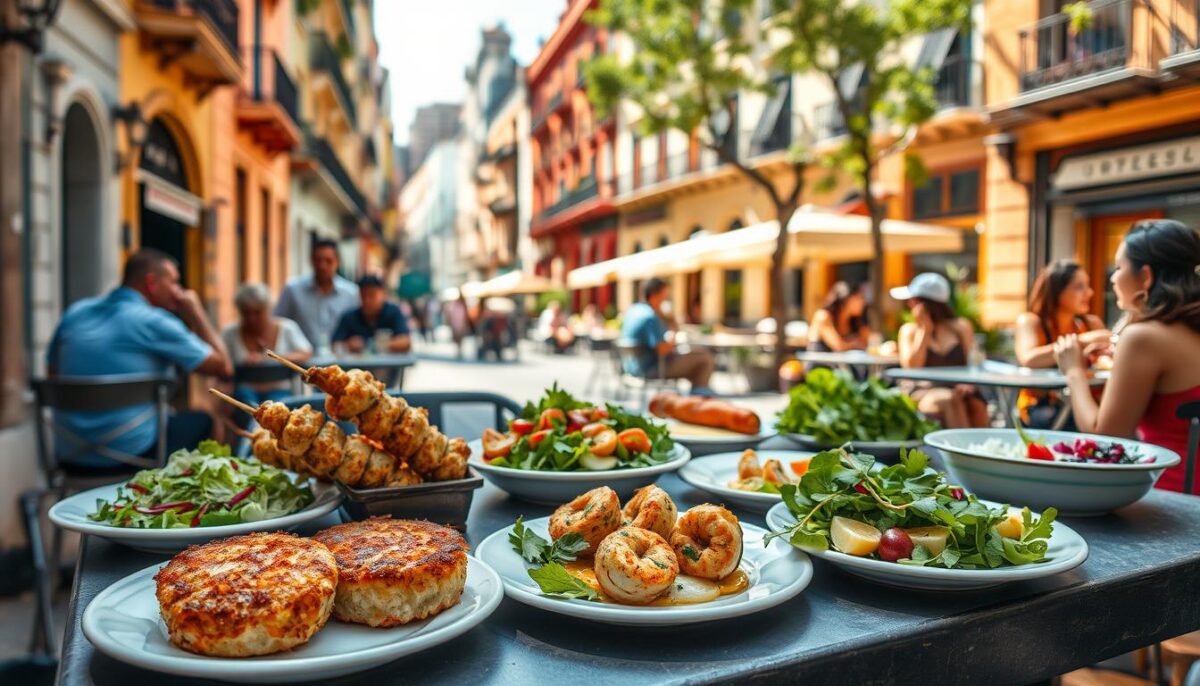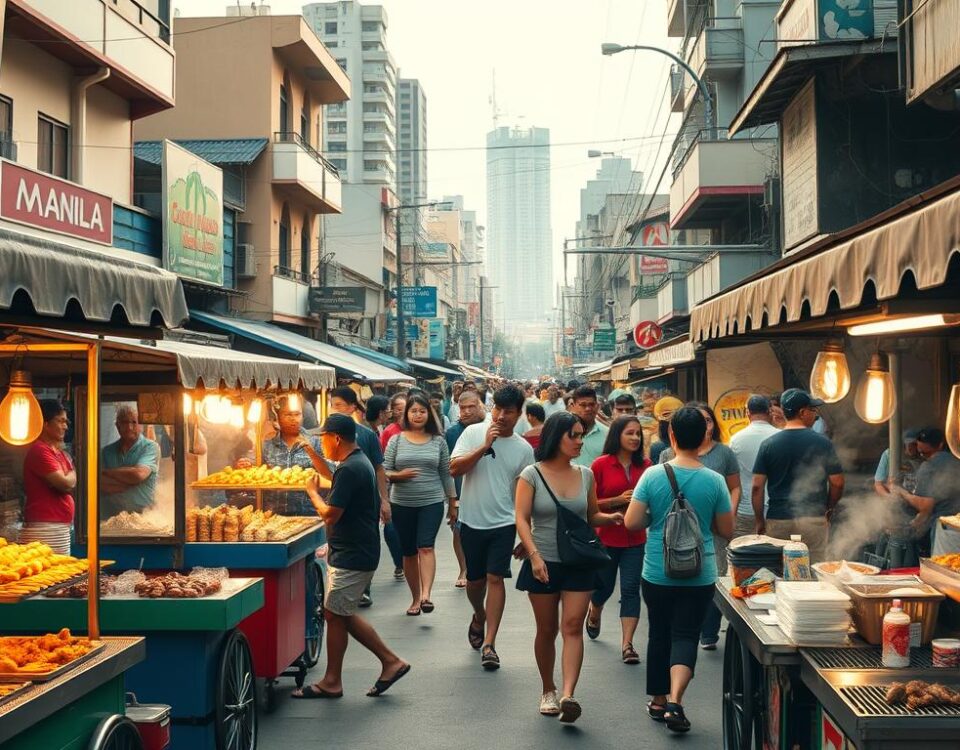
Top Local Delicacies to Discover in Lisbon’s Hidden Eateries
June 10, 2025
5 Local Treats You Shouldn’t Miss in Rio de Janeiro
June 11, 2025Did you know Buenos Aires has more restaurants per capita than Paris? On my first night here, I wandered into a tucked-away bodegón where the scent of sizzling chorizo and chimichurri stopped me mid-step. A local handed me a glass of Malbec and said, “This is where the city’s soul lives.” That moment sparked my obsession with uncovering what makes this place a culinary powerhouse.
The city thrives on contrasts. One block smells of smoky asado grills, the next hums with modern bistros blending Italian and Spanish traditions. I’ve spent years chasing flavors here—from empanada carts in San Telmo to century-old steakhouses where waiters carve meat tableside like artists. It’s not just about eating; it’s about stories shared over shared plates.
This guide isn’t a checklist. It’s a roadmap to authentic connections—the kind you’ll find in family-run kitchens and tucked-away markets. Let’s ditch the tourist traps and dive into where the locals go when they crave something real.
Key Takeaways
- Buenos Aires is a culinary capital with over 6,000 dining spots blending tradition and innovation.
- Authentic experiences often hide in neighborhood joints, not just trendy districts.
- The fusion of Indigenous, European, and global flavors defines modern Argentine cuisine.
- Local markets offer budget-friendly ways to taste regional specialties.
- Seasonal ingredients drive menu changes at even the most established restaurants.
Introduction to Buenos Aires Culinary Adventures
My first morning in the city began with the clatter of coffee cups and the sizzle of chorizo from a corner café. A vendor waved me over, pressing a warm empanada into my palm before I could say “gracias.” That’s when I realized: here, food isn’t just eaten—it’s lived.
My Personal Journey in Flavor Exploration
I spent days chasing stories through crowded markets like Mercado de San Telmo. One afternoon, a cheesemonger insisted I try five varieties of queso de oveja, each paired with local honey. “This,” he grinned, “is how we talk without words.”
Dinners became rituals. Families shared milanesa platters at worn wooden tables, while waiters recited daily specials like love poems. Even the simplest meal felt sacred—a chance to connect through generations-old recipes.
What surprised me most? The city’s culinary passion thrives in unexpected places. A baker’s secret factura recipe, a butcher’s precise asado timing—these details shape daily life here. Come taste it yourself, and let every bite rewrite your idea of adventure.
Argentine flavor Buenos Aires: A True Culinary Experience
The sizzle of a parrilla grill stopped me in my tracks on a cobblestone street—that’s when I tasted Argentina’s soul on a fork. This city’s food isn’t just cooked; it’s crafted through generations of shared stories and immigrant ingenuity.
What Makes It Unique
Local chefs call it “alma en el plato”—soul on the plate. Dishes here blend Indigenous corn-based recipes with Italian pasta techniques and Spanish olive oil traditions. Three elements define the taste:
- Wood-fired grilling that caramelizes meat perfectly
- Hand-chopped chimichurri made daily
- Provolone melted over open flames
Essential Local Ingredients and Techniques
At Mercado de Liniers, butchers age beef for 21 days using methods from 19th-century gauchos. Bakers still proof bread in linen cloths like their Sicilian grandparents did. The magic lies in simplicity:
- Grass-fed beef from Pampas ranches
- Smoked paprika rubbed by hand
- Dough kneaded for empanadas until translucent
One cook told me, “We don’t follow recipes—we inherit them.” That’s why every bite in Buenos Aires feels like a handshake across centuries.
Exploring Traditional Asado and Parrilla Culture
Sunday afternoons here smell like smoldering quebracho wood and laughter. I learned quickly that asado isn’t just barbecue—it’s Argentina’s heartbeat. Families gather for hours around glowing coals, where cuts like entraña (skirt steak) and tira de asado (short ribs) transform into communal art.
Understanding the Asado Tradition
At a friend’s backyard gathering, the parrillero (grill master) showed me his secret: “We cook with patience, not clocks.” True asado uses indirect heat from hardwoods, slow-roasting meats for up to five hours. This ritual dates back to gauchos cooking over campfires—now it’s how locals celebrate birthdays, victories, and ordinary Sundays.
The Art of Parrilla Dining
Stepping into a classic parrilla restaurant feels like entering a meat cathedral. Waiters present sizzling platters of bife de chorizo (sirloin) with the pride of gallery curators. Modern spots add craft beers, but the soul remains:
- Butchers select grass-fed cuts daily
- Grills stay lit from lunch until midnight
- Tables share steak like passed heirlooms
One chef told me, “Our parrillas keep history alive—every flame honors those who came before.” In Buenos Aires, this tradition isn’t preserved—it’s lived, one perfect bite at a time.
Top Must-Try Dishes in the City
Crispy pastry shells shattered under my fork at La Cocina, revealing molten beef filling—my first real empanada moment. This city turns simple dishes into edible legends, blending immigrant traditions with local flair.

Empanadas, Steak, and Other Signature Plates
Start with empanadas—each neighborhood has its style. The baker at El Sanjuanino taught me the code: crimped edges mean beef, straight folds signal ham-and-cheese. Their humita (creamy corn) version made me rethink savory pastries entirely.
For steak lovers, skip the filet mignon. Seek ojo de bife (ribeye) at Parrilla Peña—their grill marks tell stories of perfect timing. A chef once whispered, “Good beef needs only salt and fire.” Avoid rookie mistakes by studying common steak errors before ordering.
Three dishes define local food culture:
- Provoleta: Grilled provolone drizzled with oregano honey
- Choripán: Chorizo sandwiches bursting with chimichurri
- Milanesa napolitana: Breaded veal topped with ham and melted cheese
At Café de los Angelitos, I discovered how cheese transforms meals. Their sorrentinos (stuffed pasta) ooze gouda and walnut cream—a nod to Italian roots with Argentine twists. Every meal here bridges generations, proving tradition and innovation can share a plate.
Hidden Gems: Local Bodegones and Authentic Neighborhood Spots
The rhythmic clang of a streetcar bell led me down a San Telmo alley where time moves slower. Tucked between antique shops, family-run bodegones serve generations-old recipes to regulars who’ve claimed the same tables for decades.
Discovering San Telmo Treasures
At El Federal, a neighborhood institution since 1864, the marble counters bear knife scars from countless chorizo slices. The owner José handed me a matambre arrollado (stuffed flank steak) whispering, “This is how we ate when meat was scarce.” His great-grandmother’s recipe uses raisins and olives—a taste of culinary survival.
Three signs you’ve found a true local spot:
- Menus handwritten on chalkboards
- Waiters who remember your drink order
- Shared tables with mismatched chairs
| Venue Type | Atmosphere | Price Range | Specialty |
|---|---|---|---|
| Tourist Restaurants | Loud, English menus | $$$-$$$$ | Filet mignon |
| Neighborhood Bodegón | Conversational hum | $ | Puchero stew |
| Market Stalls | Standing counters | $ | Chorizo sandwiches |
In San Telmo’s Mercado de San Telmo, butchers toss scraps to eager dogs while slicing locally-sourced cuts. At noon, office workers queue for $3 lentil stew at Comedor Nikkō—a Japanese-Argentine fusion spot hidden behind a hardware store.
These spaces thrive on neighborhood rhythms, not Instagram trends. As José told me, “We don’t need Michelin stars when we have abuela’s apron strings.” That’s the magic of San Telmo—every meal feels like joining someone’s family dinner.
A Day in Buenos Aires: Navigating Streets and Markets
Morning light hit the cobblestones as I followed the scent of fried dough toward a cluster of umbrellas. The city’s streets transform into living menus at dawn—vendors roll carts stacked with fresh produce, while grill smoke curls above sizzling chorizo. This is where street food becomes a language everyone speaks.
Street Food Adventures
At San Telmo Market, a vendor named Luisa handed me a choripán dripping with garlicky chimichurri. “Eat it fast—the bread gets soggy,” she warned, laughing as I burned my tongue. Around us, the streets buzzed with:
- Empanada carts announcing “¡Calientitos!” (piping hot)
- Skewers of provoleta cheese caramelizing over coals
- Older men debating futbol over café cortado shots
I learned to follow the locals’ lead—they cluster where smoke rises thickest. One bite of a street food staple taught me more about culture than any guidebook.
Cultural Delights at Local Markets
Mercado de San Telmo’s iron arches shelter a symphony of clattering plates and haggling voices. A cheesemonger let me sample aged sardo while recounting his grandfather’s dairy farm. “Markets are our family albums,” he said, slicing jamón crudo with surgical precision.
| Venue | Vibe | Must-Try | Price |
|---|---|---|---|
| Tourist Markets | Photo-ready stalls | Gourmet alfajores | $$ |
| Neighborhood Markets | Conversation hubs | Homemade humita | $ |
| Street Carts | Quick-service chaos | Chorizo wraps | $ |
By afternoon, I’d eaten my way through three streets, discovering pockets of flavor most tours miss. A baker in La Boca winked as he stuffed extra dulce de leche into my factura. “Today’s your lucky day,” he said—proof that spontaneity rewards the curious.
Fine Dining Encounters: Michelin-Star Moments and Beyond
The hum of polished silverware and soft tango melodies greeted me at Don Julio’s oak door—a restaurant where cattle brands line the walls like edible history. My waiter presented a “meat library” cart showcasing dry-aged beef cuts, whispering, “We honor every muscle’s story.” Each course felt like uncovering buried treasure.
Memorable Experiences at Don Julio and Fogón Asado
At Fogón Asado’s candlelit counter, chefs transformed humble ingredients into art. A smoked provolone cheese course arrived under a glass dome filled with applewood smoke—theatrical yet deeply rooted in tradition. “Modern techniques,” explained the sommelier, “but gaucho soul.”
Three ways fine dining here surprises:
- Menus change weekly based on ranch deliveries
- Waiters explain cattle breeds like wine vintages
- Desserts reinterpret childhood treats with gold leaf
Don Julio’s dinner service became my masterclass in precision. Their signature cuts arrived with custom knives and a criolla sauce tasting flight. Yet the true magic? How linen napkins and antique decor made the experience feel welcoming, not stuffy.
These restaurants prove elegance doesn’t erase authenticity. As Fogón’s chef told me while plating dulce de leche foam, “Great food needs two things—memory and surprise.” Book months ahead, wear your stretchy pants, and let these kitchens rewrite your definition of a perfect menu.
Beyond Meat: Exploring Veggie and Seafood Selections
A tangy whiff of lemon zest pulled me into a sunlit Palermo kitchen where chefs were plating grilled provoleta beside emerald-green zucchini flowers. “Meat doesn’t own this city,” laughed the cook, handing me a crispy rabas (fried squid) drizzled with lime cream. Buenos Aires surprises those who look beyond its famous steaks.

Local Seafood Delights and Vegetarian Finds
The food scene here thrives on reinvention. At Gran Dabbang, I tasted roasted pumpkin smothered in smoked cheese sauce—a dish that made even staunch carnivores pause. Coastal influences shine in:
- Corvina negra: Black sea bass crusted with quinoa
- Bondiola de pulpo: Octopus slow-cooked like pork shoulder
- Humita tart: Sweet corn custard in flaky pastry
| Traditional Meat Dish | Modern Veggie Alternative | Key Ingredient |
|---|---|---|
| Asado short ribs | Grilled eggplant steaks | Smoked paprika |
| Choripán | Portobello mushroom sandwich | Chipotle cream |
| Provoleta | Grilled halloumi | Lemon thyme |
One chef confided, “We’re a country of ranchers, but even gauchos crave zucchini sometimes.” Menus now balance heritage with creativity—think beetroot meatballs or spinach ravioli in saffron sauce. The real magic? How kitchens honor tradition while embracing change.
Don’t miss Mercado de los Carruajes’ food stalls. I devoured seaweed-topped sorrentinos there, their ricotta filling bursting with briny freshness. Whether you’re vegan or just curious, this city proves great food needs no passport—just an open mind.
A Walk Through History: Iconic Cafés and Bakeries
The clink of porcelain against silverware echoed through the marble-lined room as I stepped into a century-old institution—where every espresso cup holds a story. These spaces aren’t just coffee shops; they’re living museums where pastries become time machines.
Savoring Medialunas and Classic Pastries
My first bite of a warm medialuna revealed its secret: 27 buttery layers folded by hand since 1930. Bakeries here treat pastries like heirlooms. At El Sanjuanino, the chef showed me his “flavor map”:
- Crescent-shaped medialunas dusted with lemon zest
- Spiral facturas filled with quince paste
- Dulce de leche-filled pastries glazed with burnt sugar
“Each layer represents a decade of history,” he said, brushing flour off his apron. I watched regulars dunk vigilantes biscuits into thick hot chocolate—a ritual unchanged since the 1920s.
The Cultural Significance of Café Tortoni
Wood-paneled walls whispered tales at Café Tortoni, founded in 1858. A waiter pointed to Borges’ favorite booth, where writers once debated over submarinos (melted chocolate in milk). Their menu bridges eras:
| Classic | Modern Twist | Key Ingredient |
|---|---|---|
| Dulce de leche tart | Lavender-infused version | Organic milk |
| Churros | Matcha-dusted | Argentine wheat |
| Ice cream sundae | Spiced pear topping | Patagonian berries |
As I tried their signature ice cream—swirled with dulce de leche and crushed alfajores—a pianist played tango melodies. “We keep the soul alive,” the manager told me, “but let tastes evolve.” These cafés don’t just serve food; they preserve culture one flaky bite at a time.
Sip, Savor, and Celebrate: Beverages That Define the Experience
The clatter of cocktail shakers and laughter spilled onto the sidewalk as I ducked into a dimly-lit bar. A bartender slid me a glass of Malbec so deep red it seemed to hold every sunset over the Pampas. “Drinks here aren’t just poured—they’re shared,” he said, nodding toward friends clinking glasses of fernet con coca at a corner table.
From Malbec Wine to Fernet con Coca
Locals treat beverages like culinary partners. At a San Telmo chorizo stand, I learned why they serve herbaceous fernet with cola: “The bitterness cuts through smoky meats better than any sauce.” Three sips define the scene:
- Malbec: Paired with provoleta cheese, its plum notes enhance wood-fired flavors
- Café cortado: Sipped slowly with medialunas at 4 PM sharp
- Submarino: Chocolate melted in steamed milk—a sweet nightcap
Creative twists surprise even regulars. One mixologist shapes ice into miniature obelisks using antique molds. Another adds smoked sea salt to lemonade, served in repurposed wine bottles. “Why drink from boring glasses?” laughed a server handing me sangria in a hollowed-out grapefruit.
| Drink | Modern Twist | Perfect Pair |
|---|---|---|
| Fernet con Coca | Basil-infused cola | Spicy choripán |
| Malbec | Barrel-aged sangria | Blue cheese empanadas |
| Dulce de leche latte | Cardamom foam | Alfajor cookies |
That first coffee taught me more than caffeine rituals. At Café La Poesía, regulars debate futbol over cortados while scribbling poetry on napkins. “Our cups hold conversations,” explained the owner, polishing espresso spoons. Whether you’re clinking craft beers or sharing yerba mate circles, every drink here invites connection—proof that savoring extends far beyond the plate.
Conclusion
My fork clinked against an empty cheese plate as twilight painted the sky violet—a perfect moment to reflect. This city doesn’t just serve meals. It serves heritage on every sizzling platter and steam-kissed medialuna.
From steak carved tableside to chorizo snapped fresh off grills, each dish carries generations of tradition. I’ve learned to read menus like love letters—searching for clues about butchering techniques or a baker’s hometown. Even simple coffee rituals here feel sacred.
Three truths guide every neighborhood exploration:
- Passion hides in handwritten specials boards
- Life unfolds around shared market counters
- Meats tell stories when cooked with patience
Let this guide be your compass, not your script. Wander past tourist zones until you hear cooks debating asado temperatures. Taste that first golden pizza slice where flour dust hangs in the air like edible confetti.
Every bite here becomes part of your story. Now—go write yours.
FAQ
What’s the best way to experience authentic asado culture?
Head to a local parrilla like Don Julio or Fogón Asado. Order chorizo, beef cuts like entraña, and pair them with chimichurri. Trust me, the smoky aroma and communal vibe make it unforgettable.
Are there vegetarian-friendly options in the city?
Absolutely! While steak dominates menus, I’ve found crispy empanadas filled with spinach or humita, grilled provoleta (melted cheese), and fresh salads at spots like Hierbabuena in San Telmo.
Where can I try the best street food?
Wander through Mercado de San Telmo. Grab a choripán (sausage sandwich) from a vendor or dulce de leche-stuffed churros. The energy here—mixed with sizzling grills and live music—is pure magic.
What’s a must-try dish beyond steak?
Don’t skip provoleta (grilled cheese with oregano) or milanesa napolitana (breaded meat with tomato sauce and cheese). For dessert, alfajores filled with dulce de leche are life-changing.
How do locals typically enjoy their coffee?
Cafés like Café Tortoni serve cortados (espresso with milk) alongside medialunas (sweet croissants). It’s a morning ritual—slow sips, people-watching, and soaking in the history.
Is San Telmo worth visiting for food?
100%. Its cobblestone streets hide bodegones (old-school eateries) serving classics like lentil stew or gnocchi on the 29th of each month. Plus, the Sunday market is a feast for the senses.
What drink pairs best with Argentine dishes?
A bold Malbec from Mendoza elevates grilled meats. For something stronger, locals love Fernet con Coca—a bitter herbal liqueur mixed with cola. Try it at a neighborhood bar!
Where can I find historic cafés with charm?
Café Tortoni, opened in 1858, feels like stepping into a time capsule. Order submarino (hot chocolate) and watch tango dancers. La Poesia in San Telmo is another gem with literary vibes.



